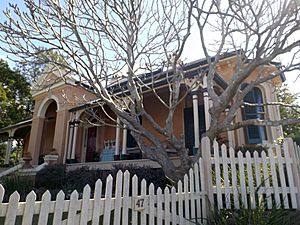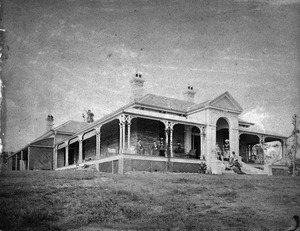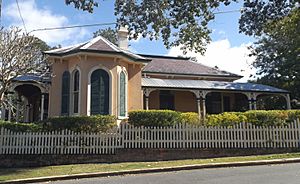Wilston House facts for kids
Quick facts for kids Wilston House |
|
|---|---|

Residence in 2015
|
|
| Location | 47 Watson Street, Newmarket, City of Brisbane, Queensland, Australia |
| Design period | 1870s - 1890s (late 19th century) |
| Built | c. 1876 - c. 1880 |
| Built for | William Wilson |
| Architect | James Cowlishaw |
| Official name: Wilston House | |
| Type | state heritage (landscape, built) |
| Designated | 21 October 1992 |
| Reference no. | 600344 |
| Significant period | 1870s, 1880s (fabric, historical) |
| Significant components | residential accommodation - main house, trees/plantings, garden/grounds |
| Lua error in Module:Location_map at line 420: attempt to index field 'wikibase' (a nil value). | |
Wilston House is a beautiful old house located at 47 Watson Street in Newmarket, Brisbane, Queensland, Australia. It was designed by a famous architect named James Cowlishaw. The house was built between about 1876 and 1880.
This historic home is so important that it was added to the Queensland Heritage Register on 21 October 1992. This means it's protected because of its special history and design.
Contents
The Story of Wilston House
Building a Grand Home
Wilston House is a large, single-story brick house. It was built around 1876 for William Wilson. He was a successful businessman who bought and sold goods and helped people with insurance. He also served in the Queensland Legislative Council, which was like a part of the government, from 1874 to 1878.
The area where the house stands, now known as Wilston, was actually named after this very house! For many years, Wilston House was a well-known landmark in the Newmarket-Wilston area.
William Wilson was born in Ireland around 1832. He came to Australia in 1857 and then to Queensland in 1858. He married Mary Coutts and they lived in Brisbane. William was a public figure and a Freemason.
The architect, James Cowlishaw, had worked with William Wilson before. In 1861, Cowlishaw designed a brick cottage for Mr. Wilson in Mary Street. This shows they had a long working relationship.
The Land and Its Neighbors
Wilston House was built on a large piece of land. William Wilson bought this land in 1868 and combined it with another piece he owned. This created a huge property of about 35.5 hectares (87.5 acres).
In the 1860s and 1870s, this area was mostly farmland. Some wealthy families also had large country homes here. These estates were almost like small farms themselves, with gardens, orchards, and animals. Wilston House was part of this tradition of grand country homes.
How Wilston House Changed Over Time
In July 1876, James Cowlishaw started looking for builders for a "villa residence" for William Wilson. This was Wilston House.
Early Design and Additions
Early photos from the late 1870s show the house was made of brick. It had wide verandahs (porches) on three sides. There was also a timber (wooden) section at the back with a bay window. This wooden part might have been a large room that could be divided into smaller guest rooms. It could even be opened up for a ballroom!
Later photos, taken before 1885, show that the brick walls were covered with a smooth finish. Bay windows were added to the front rooms. The house also had three terraces (flat areas) in the front garden. The lowest terrace was used for games like croquet or tennis. The Wilsons would even set up a dance floor and a tent there for parties.
The last big event William Wilson held at the house was his stepdaughter's wedding in December 1884. After that, he went on a trip to America and Ireland.
New Owners and Changes
In 1884, William Wilson borrowed a large sum of money, £5,000, from Sir Arthur Hunter Palmer. Sir Arthur was a former Premier of Queensland and lived nearby. Soon after, in October 1884, Wilston House was sold to John Stevenson, another important Brisbane politician.
The Wilsons moved out, and Stevenson divided the large estate into smaller blocks around 1884-85. In May 1885, Wilston House was put up for auction with about 8 acres of land. It was described as having elegant drawing and dining rooms, a library, five bedrooms, and verandahs. The property also had stables, a carriage-house, and gardens.
Wilston House didn't sell right away and was rented out. A man named James Tolson lived there for a few years. He even experimented with freezing lamb to send to Britain!
The house remained a rental property until 1898. Then, it was bought by Boyd Dunlop Morehead, who was also a former Premier of Queensland. He had caretakers live there, but they left in 1899. The house then went to the Queensland National Bank.
The Cahill Family and Royal Visits
In 1900, the Queensland National Bank sold Wilston House to Major WG Cahill for £1230. Major Cahill was a very important person in Queensland. He was the head of the Justice Department and later the Commissioner of Police. He lived at Wilston House from at least 1906.
It is believed that the Duke of Cornwall and York (who later became King George V) visited Wilston House in May 1901. He was on a Royal Tour to celebrate Australia becoming a federation. The Governor of Queensland, Lord Lamington, was with him.
Later Renovations and Subdivisions
In December 1925, the land around Wilston House was divided again and sold. Major Alex Wynyard-Joss bought the house and a little over one acre of land. Major Cahill continued to live there as a tenant until about 1928.
In the late 1920s, the old timber extension and service wing at the back of the house were removed. A new verandah was built in their place. Major Wynyard-Joss also updated the inside of the house. He added electricity, a new bathroom, and a new kitchen. He moved into Wilston House with his wife in 1930.
In the 1940s, the house block was made even smaller. Parts of the garden were sold for other houses to be built. Major Wynyard-Joss passed away in 1954, and the property eventually went to his daughter. In 1982-83, a small studio cottage was built in the garden.
What Wilston House Looks Like
Wilston House sits on top of a hill, looking over the areas of Wilston and Newmarket. It's a large, single-story brick house. Its style is mostly Georgian, which is a classic architectural look, but it also has wide verandahs that are typical of Australian homes.
Inside the House
The main part of the house has a central hallway and six rooms. The roof is covered with Welsh slate tiles. The front entrance has a grand rendered masonry portico (a porch with columns and a triangular roof).
Each room has French doors with arched windows that open onto the verandahs. The verandah roofs are made of curved iron and are supported by pairs of wooden posts.
The brick walls that were added in the 1880s were covered to look like cut stone. The outside of Wilston House still looks very much like it did in the past.
Inside, the house is also mostly unchanged. The hallway floor is made of cedar wood, and much of the wooden trim is also cedar. The other floors are made of pine. Some rooms have beautiful pressed metal ceilings and cast iron mantelpieces, which were added in the 1880s.
The house has been updated for modern living. A bathroom is now in what used to be the linen room, and the kitchen is in a former bedroom.
The Gardens and Trees
The land around Wilston House is now a regular suburban block. A new brick studio has been built in one corner.
The gardens still have some very old, large trees. In the northwest corner, there's a huge Moreton Bay Fig tree that might be as old as the house itself. Across Watson Street, there's a large Weeping Fig, a Jacaranda, and a Tupelo tree. These trees were once part of the Wilston House grounds and are from the late 1800s or early 1900s. They are also part of the heritage listing.
Why Wilston House is Important
Wilston House was listed on the Queensland Heritage Register in 1992 for several reasons:
A Glimpse into Queensland's Past
Wilston House and its gardens show us how wealthy families lived on the hilltops north of Brisbane in the 1870s. It helps us understand the lifestyle of middle-class people in Brisbane during that time.
A Great Example of Its Kind
Built around 1876, Wilston House is a very well-preserved home. It's special because of its brick, cedar, and slate construction. Its Georgian style makes it a great example of houses from that period.
The old trees in the garden, like the Moreton Bay Fig and Weeping Fig, are important too. They show us what kind of plants were chosen for gardens back then. These trees also make Wilston House a beautiful landmark on Wilston Hill.
Its Beauty and Location
Wilston House is important because it's a landmark. It adds to the beauty and history of the Wilston and Newmarket areas.
The old trees in the garden also add to its beauty and history. They are important for showing how gardens were designed in the late 1800s and early 1900s. They also help make Wilston House stand out on Wilston Hill.
Connected to Important People
Wilston House is a good example of the work of James Cowlishaw. He was a very busy and important architect in Brisbane.
Images for kids





